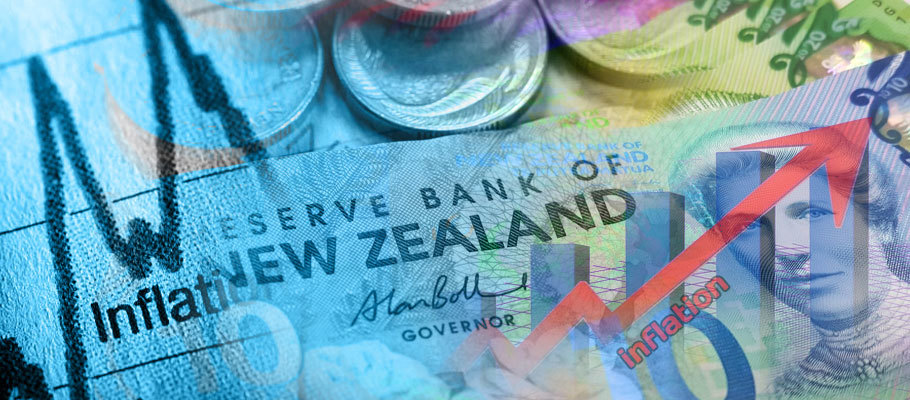
Published: July 20th, 2022
The Kiwi lagged other G10 currencies at the start of the week after a surge in New Zealand inflation rates shocked forex traders and raised expectations for a faster cycle of interest rate hikes by the Reserve Bank of New Zealand (RBNZ).
Now fears of a 'hard landing' for antipodean island’s economy are rising as traders worry that a toxic blend of rising interest rates and high inflation will snuff out economic growth. Those fears are likely behind NZD's negative response to the data release.
Figures from Stats NZ show CPI inflation in New Zealand rose 1.6 per cent in Q2, exceeding the 1.4 per cent markets were looking for.
At the end of the second quarter, the annual inflation rate stood at 7.2 per cent, a 30-year high that creeped beyond the 7.1 per cent forecast and the 6.9 per cent measured at the end of Q1 2022.
Forex analysts responded by raising their expectations for an RBNZ interest rate hike.
‘This week’s inflation print supports our call for a 4th consecutive 50bps rate rise at the RBNZ’s August meeting,’ said an analyst note from TD Securities’ global FX strategy unit. 'Softer growth data and higher inflation continue to surprise central bankers.’.
The Kiwi’s reaction is a shocker, the bank’s analysts say, because a combination of strong domestic inflation and rising rate hike expectations tend to be supportive of a fiat currency.
In this case, traders are interpreting the data as a signal that higher inflation and rising interest rates could send New Zealand’s economy into recession, or at least a downturn.
Forex traders and investors were near unanimous in their assessment of the data, as NZD was down against all G10 rivals in the immediate aftermath of the release.
Karen Zellner, Chief Economist at ANZ Bank, told Bloomberg that 'the CPI reading was far enough above our and the RBNZ’s expectations to put currency markets on the back foot. Taken with other core measures, we’re now reading a sense of unease that an outsize rate increase of 75bp might be in the cards. In short, worries about a hard landing for New Zealand’s economy are growing.’
The Sterling to New Zealand Dollar exchange rate rose 0.87 per cent on Tuesday, 19th July to 1.9378. The New Zealand Dollar-U.S. Dollar rate fell to 0.6182. The Euro-New Zealand Dollar rate rose to 1.6446.
The threat of an economic slump has some analysts already on the lookout for future rate cuts as the RBNZ re-balances in the face of economic contraction and falling inflation. Those predictions may be driving the Kiwi’s current negative trajectory.
If so, it would mean traders are looking beyond near-term rate hikes and already pricing in the potential for a negative growth outlook and future rate cuts.
In late June, ANZ analysts predicted that the key driver for NZD in Q3 would be global investor confidence, putting the Kiwi at risk of further declines, especially against the US Dollar.
'Risk appetite and NZD valuations have both had a shaky start in the last week of Q2,’ ANZ said in a note to investors. ‘Oil prices and expectations for an interest rate rise have both fallen back, however the observable swings in US rates and NZD price action is being driven by hesitant offshore investors.'
Global markets were struggling to make gains in June thanks to higher energy prices and an accelerating cycle of central bank interest rate hikes, particularly from the world's most influential central bank, the US Fed.
It started off a series of higher-than-expected rate hikes, raising the cost of borrowing in the US with knock-on effects across the globe.
That placed the growth-sensitive Kiwi on a path to underperformance, ANZ said.
NZD performed well in the first half of 2022, holding its own among G10 majors and rallying past a new technical milestone in April. Analyst consensus at the time was that more gains were possible in 2022, though a few counselled caution, believing a downside correction might be building.
Before reaching its April high point, NZD was behind other commodity-currency peers the like the Norwegian Krone and Australian Dollar, then a rally began. NZD challenged two levels of technical resistance and then started inching up against USD, helped by gains in agricultural commodity prices.
‘Macro factors will determine the next moves for the Kiwi,’ ANZ said. 'The good news for NZD bulls is that rising commodity prices and higher bond yields will both provide support for the forseeable future.’
In January 2022, the Reserve Bank of New Zealand said it believed the need was there to raise interest rates in excess of what had been discussed in the final weeks of 2021. That was in response to domestic inflation pressures and a changed economic outlook that pushed up forecasts for the country’s official cash rate.
ANZ analysts, however, were more cautious in their assessments of the country's growth prospects and said at the time that the greenback could rise further and push NZD back in the near term.
The bank assessed NZD’s outlook for the remainder of 2022 as 'partially clouded.’ This was due to factors including lower-than-expected housing starts, higher-than-expected interest rates, and volatile commodity prices. Those predictions proved prescient.
‘Inflation is on the up, and we believe traders will have to factor in the impact of higher real rates by mid-year,’ ANZ said in January. 'Inflation is already rampant in America, and looking at previous periods where these factors dominated, the long USD rally seen in late 2021 may have some way to go yet’.
ANZ said parallels with earlier periods could point to where NZD prices are going given its early-year outperformance. The Kiwi has been sensitive to shifts in US bond yields in the past, and tended to move whenever there were big changes to US Fed rate policy.